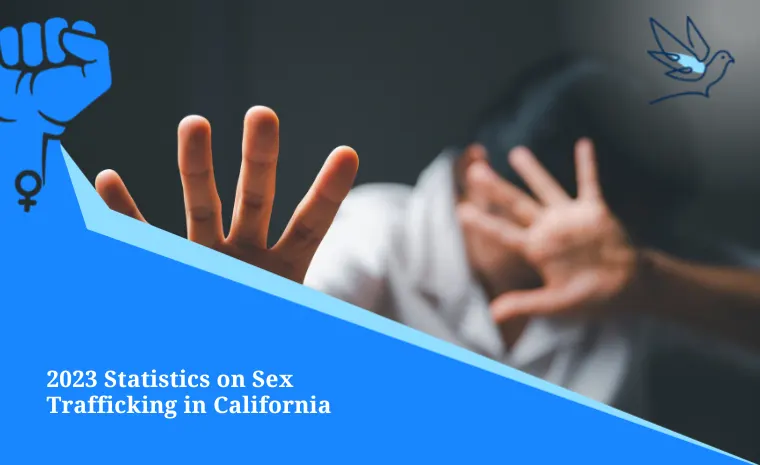2023 Statistics on Sex Trafficking in California
Sex trafficking, a form of modern-day slavery, involves the recruitment, transportation, and exploitation of individuals through force, fraud, or coercion for the purpose of sexual exploitation. Men, women, and children, irrespective of age, gender, or background, fall prey to this abhorrent crime.
California, with its extensive coastline, border proximity, and diverse population, becomes an attractive destination for traffickers seeking to profit from the vulnerability of individuals seeking better lives.
Major cities like Los Angeles, San Francisco, and San Diego, along with their sprawling entertainment industries, provide fertile ground for the commodification of human beings. Moreover, the state’s large immigrant population, economic disparities, and social inequalities further compound the risk factors for exploitation.
In this blog, we will discuss:
- 2023 California sex trafficking statistics
- Prevalence of sex trafficking in California
- What Can Be Done to combat sex trafficking in California?
Have you or a loved one been a victim of sex trafficking?
2023 California Sex Trafficking Statistics
By examining the latest available statistics, we can gain a clearer understanding of the magnitude of the issue and reinforce our collective determination to eradicate sex trafficking.
While acquiring accurate figures on sex trafficking remains challenging due to its hidden nature, the available data provides valuable insights into the scale and scope of the problem. According to law enforcement agencies, victim service providers, and anti-trafficking organizations, the following statistics offer a snapshot of the sex trafficking landscape in California in 2023:
- The U.S. Department of State reports that an estimated 27.6 million individuals are currently victims of trafficking worldwide.
- Of all 50 states, California ranks first in reported sex trafficking cases, with 1,023 cases as of 2021.
- The National Human Trafficking Hotline reports that its hotline received 50,123 signals in 2021.
- Nearly 9 in 10 reported human trafficking cases involve sex trafficking.
- From 2015 to 2021, human trafficking cases that involved sex trafficking have risen from 87% to 89% in California.
In February 2023, forty-eight people were arrested in San Diego for allegedly selling 41 people into sexual slavery. Of these 41 individuals, 8 were child sex trafficking victims, with the youngest being 13 years old.
The arrest followed a month-long investigation that was carried out by local, state, and federal law enforcement officials.

Prevalence of Sex Trafficking in California
The prevalence of sex trafficking in California is a harsh reality that demands our attention. However, as previously mentioned, gathering accurate statistics can be challenging due to its secretive nature. It is widely acknowledged that California serves as a significant hub for sex trafficking in the United States.
The impact of sex trafficking is profound, leaving a significant impact on survivors of sex trafficking. These trafficking victims endure physical, emotional, and psychological trauma. The consequences of this do not only affect the victim on an individual level, but may also affect families, neighborhoods, and society as a whole.
Sex trafficking thrives in California due to several various factors that make the state an attractive location for sex traffickers. While it is important to note that sex trafficking occurs in many regions around the world, several key elements contribute to its prevalence in California:
Geographic Location
California’s strategic geographical location plays a significant role in sex trafficking activities. Its extensive coastline, international borders, and proximity to major transportation routes make it an attractive entry point for both domestic and international trafficking networks. Traffickers exploit these access points to transport victims and maximize their illicit activities.
Large population and Urban Centers
California is the most populous state in America, with diverse and densely populated urban centers. The high concentration of people provides a large pool of potential human trafficking victims and a significant demand for commercial sex.
As previously mentioned, major cities such as Los Angeles, San Francisco, and San Diego, known for their vibrant entertainment industries and tourism, attract both human traffickers and consumers of the sex trade.
Entertainment Industry
California’s entertainment industry, particularly Hollywood, creates an environment where various types of exploitation can flourish. There is an abuse of power when traffickers capitalize on the dreams and aspirations of individuals seeking fame and fortune, luring them into situations of vulnerability and coercion. The industry’s demand for glamour and beauty can also perpetuate a culture that objectifies individuals and fuels the demand for commercial sex.
Economic Disparities and Inequality
The presence of economic disparities and social inequalities in California contributes to the vulnerability of marginalized populations. Poverty, homelessness, and lack of access to education and employment opportunities create conditions where individuals are more susceptible to exploitation by traffickers. Traffickers prey upon those facing economic hardships, promising them better lives or employment opportunities, only to subject them to exploitation.
Immigration Routes and Vulnerability
California shares a border with Mexico, making it a key entry point for individuals crossing into the United States. Traffickers exploit the vulnerabilities of undocumented immigrants, offering false promises of safe passage or employment, only to force them into situations of sexual servitude. The fear of deportation and lack of protection due to immigration status can keep victims silent and trapped.
Internet and Technology
The rapid advancement of technology has opened new avenues for sex trafficking, and California, as a hub for technological innovation, is not exempt. Online platforms and social media provide traffickers with a convenient and discreet means to advertise victims, arrange transactions, and connect with buyers. The anonymity and global reach of the internet further complicate efforts to combat online sexual exploitation.
What Can Be Done to Combat Sex Trafficking in California?
Combating sex trafficking in California requires a comprehensive approach involving multiple stakeholders and addressing various aspects of prevention, protection, and prosecution. Here are some key actions that can be taken to combat sex trafficking:
Raise awareness and education
Education plays a vital role in preventing forms of sex trafficking. Increasing awareness of sex trafficking among the general public, schools, communities, and potential victims about the tactics, signs, and consequences of trafficking can help individuals recognize and avoid dangerous situations. Educational campaigns, workshops, and training programs should be implemented to empower people with knowledge and equip them to protect themselves and others.
Strengthen legislation and law enforcement
Governments should enact and enforce robust legislation that criminalizes all forms of trafficking and ensures severe penalties for perpetrators and human trafficking offenses.
Law enforcement agencies need adequate training and resources to effectively investigate cases, dismantle trafficking networks, and bring traffickers to justice. Collaboration and coordination among local, national, and international law enforcement agencies are essential to combat the transnational nature of sex trafficking.
Support and protection for survivors
Survivors of sex trafficking require comprehensive support services to aid their recovery and help them rebuild their lives. This includes safe housing, access to medical care, mental health counseling, evidence-based care, legal assistance, education, vocational training, and employment opportunities.
Empowering vulnerable communities
Addressing the root causes of sex trafficking requires efforts to empower vulnerable populations. This includes initiatives to alleviate poverty, domestic violence, provide quality education, promote economic opportunities, and strengthen social safety nets.
Targeted interventions should focus on addressing the specific vulnerabilities faced by marginalized communities, including addressing systemic inequalities, homeless youth, addiction issues, and lack of access to healthcare.
Enhance online safety and accountability
Internet platforms should implement stringent policies to identify and remove illegal content related to trafficking. Collaboration between tech companies, law enforcement, and NGOs is essential to develop innovative solutions to detect and disrupt online trafficking activities.
Support survivor-led initiatives
Survivor-led initiatives and organizations play a vital role in combating sex trafficking. Their lived experiences provide unique insights and perspectives that can inform effective strategies and policies. Supporting and amplifying the voices of survivors helps shift the narrative, reduce stigma, and provide survivors with agency and leadership roles in anti-trafficking efforts.
Help For Victims of Sex Trafficking
The Women’s Rights Group understands the trauma and suffering that the majority of trafficking victims experience. Our team is dedicated to fighting for the rights of those who have been victims of the crime of exploitation.
Have you or a loved one been a victim of sex trafficking? We believe that you must not suffer in silence. We can help you seek the justice you deserve.
Contact us today for a free consultation to discuss your legal options. We can help you recover the maximum compensation you deserve.
Call us at (844) 240-4967 or fill out our confidential online form for a free, confidential case consultation. We are available 24/7!






